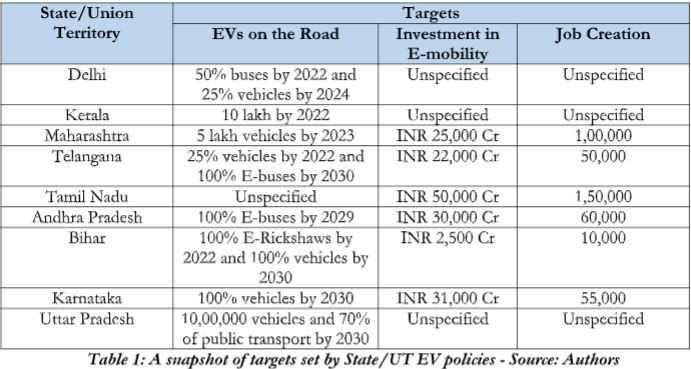ET Energy World, October 19, 2020
By Udai S Mehta and Trinayani Sen
Focused government approach coupled with coordination among the efforts at the city, state and central level as well as industry and the civil society is the key for converting the policy misses into hits.
In the fabled ‘matsyavedh’ competition of the Mahabharata, the mighty Arjuna is said to have mastered the art of focusing on the target, when he hit the fish eye to win the hand of Draupadi. However, in real life, a marksman has equal probability of hits and misses. Such is the case of the EV policies that are populating the Indian electric mobility sector. As the country braces itself for an ambitious target of achieving 30 per cent electric vehicles on the road by 2030, at least 13 states and union territories have come up with EV policies of their own to supplement the efforts of the Centre. With innovative provisions and ambitious targets, the policies are geared to heighten EV production and adoption. But, are they? What remains to be seen is where they are hitting the bulls-eye and which targets are they missing.
So, which are the provisions that have hit bullseye?
At a time when the market penetration of EVs is precariously low (less than 1 per cent) and the national targets are ambitiously high, the state policies, which are in various stages of formulation and implementation, are striking when the iron is hot. A cursory review of the EV policies reflectsa strong emphasis on time-bound targets for segment-wise vehicle registration, investment and employment generation. These are supplemented by fiscal and non-fiscal incentives for localized manufacturing and demand generation. The policies are technology agnostic and aim to develop a robust charging network and an integrated EV ecosystem.
Simultaneously, the policies aim to generate adequate opportunities for technological innovation and skill development for creating more jobs in the E-mobility sector. Some have even come up with innovative provisions such as subsidies on the basis on socio-economic conditions (Bihar) or provisions forend-of-life management of the batteries (Delhi, Punjab, Madhya Pradesh).
The objectives and targets of the individual policies are also tailor-made for catering to local priorities and capacities. For example, the Andhra Pradesh or Telangana EV policy have ambitious plans of making the state a hub of EV production and adoption, others like Kerala have opted for leveraging electric mobility for fostering environmental sustainability and shared mobility. A game changer emerges from the new kid on the block, the revised Delhi EV policy adopts a segment wise
approach for pacing up adoption.
With a comprehensive outlook and nuanced provisions, the policies look focused and target-oriented at a glance. In that case, where do they miss the bullseye?
A deeper analysis of the different state EV policies brings out an inherent disconnect between the targets envisioned by them and the common goals set by the central government. It also highlights an underlying lack of rationale behind the target-setting mechanisms. While some states have exercised restraint, others have gone for superlative figures and ambitious timelines.

On similar lines, there seem to be missing linkages between provisions in state EV policies and central policies. A case in point would be the purchase incentives provided by several policies, which are directly linked with the battery capacity of an EV. The latest advisory issued by MoRTH, which delinks battery sales from vehicle sales, defeats the purpose of these incentives unless they are decoupled from battery capacity.
As we move from missing linkages to missing provisions, a common lacuna seems to be the absence of appropriate financing mechanism, which is a critical impediment for mass-scale vehicle adoption. Additionally, deployment of charging stations is focused on state efforts with minimal impetus for private players.
Thus, while the intentions and policy direction remains progressive, the hits and misses seem to be co-existent. In such a scenario what is the way forward for realigning the policies with their intended targets?
The first step towards bridging the missing linkages is conducting need assessments and mapping exercises to understand ground realities. This will lead to better alignment of the state specific needs and targets with the central goals. Additionally, a periodic analysis of the potential impacts of the notified or drafted policies is critical, for backtracking and course correction, if any. In the long term, the focus should be on fostering targeted innovation to unravel the mobility challenges on ground.
However, in the short term, the emphasis can be on introduction of the missing provisions or revisiting existing provisions. While state-led financing maybe difficult due to limited state capacities and big banks maybe apprehensive in lending loans due to obvious risks involved in an emerging sector, the policies can focus on a mix of innovative financing mechanisms and easing out of lending restrictions. For the electrification of 2-wheelers and 3-wheelers (constituting over 80 per cent of the vehicles sold in India and 70 per cent of the on-road vehicles), micro-finance institutions could be a game changer. In order to circumvent the challenges of financing, innovative multi-sided platforms such as cab aggregators maybe prioritised by providing appropriate incentives to fleet aggregators. Further, innovative models such as public-private-partnerships or decentralised service-based models can be introduced for inviting private sector investments in charging infrastructure. Additionally, incentives should be delinked from battery capacity and EVs across speed segments should be incentivized to ensure that the Indian market is not flooded with cheap imported EVs.
Focused government approach coupled with coordination among the efforts at the city, state and central level as well as industry and the civil society is the key for converting the policy misses into hits. After all, like in the case of Arjuna, unwavering focus on the targets will help in achieving accelerated, sustainable and just transition to E-mobility.
[This piece was authored by Udai S Mehta, Deputy Executive Director and Trinayani Sen, Senior Research Associate, CUTS International]
This news item can also be viewed at:
